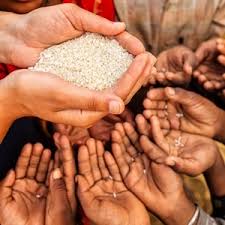
Image source
Browsing and then deeply scanning through Hungry Planet, I was struck (but not surprised) by the difference in which the world eats. Sitting from my privileged vantage point, it is so easy to look for the processed versus unprocessed food, the quantity versus the quality. One would like to think that the developed world would have more access to (and choose) “healthy” food but that is sadly not always the case. One would also like to think that money can buy an abundance of fresh fruits, vegetables, meats and grains but this is also not a given
The first photo In the Hungry Planet series that caught my attention is the photo of the family in Bhutan that feeds thirteen people on a little over $5 a day with little processed food, starch or carbohydrates. While I am not a nutritionist, I can personally say that eating a plant-based diet makes me hungry almost constantly. Without fillers, I feel that I could easily go through that family’s weekly groceries myself alone…perhaps quicker than seven days. It demonstrates to me the vast difference is in not only diet, but the divide in cultural disparity in what a “meal” consists of. Despite the Western world’s misconception of lack of food as seen in the photo, Bhutan is quite self sufficient in harvesting food for their country. Through intelligent and well planned strategy, Bhutan has risen from one of the poorest countries to one that thrives in it’s carbon neutral footprint and near abundance for it’s people. However, Bhutan is not without it’s dark side, nearly 12% of the population live below the poverty line
and experience food insecurity.
And yet on another spectrum, a prime example of being able to “afford” better due to living in a developed country would be the family from the Nunavut Territory in Canada. The seemingly reasonable amount of food for a family of five costing almost 70 times what the Bhutan’s family spends is appalling. Living in a literal food desert, their access to fresh fruits and vegetables is so limited due to geography and cost. Other cultural and race bias come into play as the native Inuit population makes, on average, a third of non aboriginals from 2005 Canadian Statistics. Many southern Canadians retort- “why not leave? Why not hunt?” but the cost involved in both are in line with the inability to feed their families in the first place. Not only seen in an area that is mostly too cold to grow abundant fruit and vegetables but we also experience socio-economic divides in our own American cities. As a privileged society, we arrogantly dictate money spent should equal the quality of food purchased, it’s humbling to see what money can actually buy.
In considering the food in developed, Western cultures one can’t help but see the amount of processed food that is no doubt more cheaply purchased through government subsidies. As articulated in “Agricultural Trade Liberalization,” “for developing countries, the point remains that the United States and the European Union still protect their agricultural sectors…many developing countries cannot afford to provide subsidy support for their own agricultural sectors” (Clapp, p. 89) In the photos we review in Hungry Planet, we see the disparity between not only the abundance but convenience of food between developed and less developed countries . One can easily see how developed (i.e. affluent nations such as the US) can afford to subsidize and export cheap commodities such as corn and soy to produce convenient meals and drive down the cost of groceries in general. Lesser developed countries, without
the privilege of being able to afford subsidizing, see their population affording much less food with more work involved in making it ready for consumption. It is yet another example of when the affluent continue to evolve exponentially faster than others, when the real need for affordable food for those that can’t acquire it.
This photo series highlights the deep and convoluted way which in affluent countries arrogantly dictate that all should eat more and healthier. Hungry Planet also further highlights that those that need the subsidies and convenient meals are the least likely to receive them. Hungry Planet helps to further show that there is a great divide that seems so inefficient and frankly, unfair.

I get pleasure from, lead to I discovered just what I used to be having a look for. You have ended my 4 day lengthy hunt! God Bless you man. Have a great day. Bye
This is really interesting, You’re a very skilled blogger. I have joined your rss feed and look forward to seeking more of your magnificent post. Also, I’ve shared your web site in my social networks!
I have a brand new car, all leather and I live in south central California. I can’t even touch my steering wheel if it’s been parked in a shopping parking lot it’s so hot! I will need this!!
Yeah, but if that steering wheel cover is sold in California, the manufacturer may be required to put that warning on the product. They aren’t gonna create different packaging for different states in most cases.